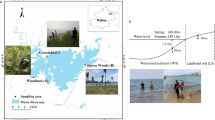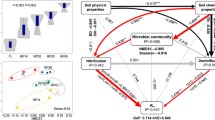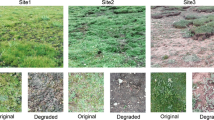Abstract
Aims
Ammonia oxidation and denitrification are crucial for nitrogen (N) availability and nitrous oxide production in N-limited permafrost soils. However, it remains unclear about the relative roles of abiotic and biotic properties in controlling the abundance and activity of ammonia-oxidizing and denitrifying microorganisms in permafrost-affected soils.
Methods
We analysed the potential ammonia oxidation and denitrification rates (PAO and PDR), the abundance of archaeal amoA, bacterial amoA, nirK, nirS and nosZ genes, soil characteristics, climatic and plant properties across two vegetation types in Tibetan permafrost-affected soils. The relative importance of abiotic and biotic properties in driving functional N gene abundance, PAO and PDR were assessed using variation partition analysis (VPA) and random forest (RF) model.
Results
The functional N gene abundance and PDR were lower in alpine steppe than in alpine meadow. Variations in the PAO and PDR and functional N gene abundance were mainly explained by abiotic variables such as organic carbon and total N, then by plant properties such as plant N concentration, plant species richness and productivity based on the VPA. The RF model showed that abiotic properties (e.g., precipitation) and plant properties (e.g., plant N concentration or plant productivity) predicted the PDR and the abundance of functional N genes. Both VPA and RF model showed that the PAO and PDR could be determined by the abundance of functional N genes such as archaeal amoA gene and nosZ gene, respectively.
Conclusions
Our study highlights that abiotic and plant properties are important predictors of the abundance and activity of ammonia-oxidizing and denitrifying communities in permafrost-affected regions, implying that plant properties, which were previously overlooked, should be incorporated into ecosystem models for improved prediction of belowground N process rates in a changing environment.







Similar content being viewed by others
References
Alves RJE, Wanek W, Zappe A, Richter A, Svenning MM, Schleper C, Urich T (2013) Nitrification rates in Arctic soils are associated with functionally distinct populations of ammonia-oxidizing archaea. ISME J 7:1620–1631
Alves RJE, Minh BQ, Urich T, von Haeseler A, Schleper C (2018) Unifying the global phylogeny and environmental distribution of ammonia-oxidising archaea based on amoA genes. Nat Commun 9:1517
Archer E (2016) Estimate permutation p-values for importance metrics. R package version 2(1):5 Retrieved from https://CRAN.R-project.org/package=rfpermute
Attard E, Recous S, Chabbi A, De Berranger C, Guillaumaud N, Labreuche J, Philippot L, Schmid B, Leroux X (2011) Soil environmental conditions rather than denitrifier abundance and diversity drive potential denitrification after changes in land uses. Glob Chang Biol 17:1975–1989
Banerjee S, Siciliano SD (2012a) Spatially tripartite interactions of denitrifiers in arctic ecosystems: activities, functional groups and soil resources. Environ Microbiol 14:2601–2613
Banerjee S, Siciliano SD (2012b) Factors driving potential ammonia oxidation in Canadian arctic ecosystems: does spatial scale matter? Appl Environ Microbiol 78:346–353
Breiman L (2001) Machine learning. Random Forests 45: 5
Bru D, Ramette A, Saby NP, Dequiedt S, Ranjard L, Jolivet C, Arrouays D, Philippot L (2011) Determinants of the distribution of nitrogen-cycling microbial communities at the landscape scale. ISME J 5: 532–542
Carey CJ, Dove NC, Michael Beman J, Hart SC, Aronson EL (2016) Meta-analysis reveals ammonia-oxidizing bacteria respond more strongly to nitrogen addition than ammonia-oxidizing archaea. Soil Biol Biochem 99:158–166
Chapin FS III, Moilanen L, Kielland K (1993) Preferential use of organic nitrogen for growth by a non-mycorrhizal arctic sedge. Nature 361:150–153
Chen YL, Xu ZW, Hu HW, Hu YJ, Hao ZP, Jiang Y, Chen BD (2013) Responses of ammonia-oxidizing bacteria and archaea to nitrogen fertilization and precipitation increment in a typical temperate steppe in Inner Mongolia. Appl Soil Ecol 68:36–45
Chen YL, Chen LY, Peng YF, Ding JZ, Li F, Yang GB, Kou D, Liu L, Fang K, Zhang BB, Wang J, Yang YH (2016a) Linking microbial C:N:P stoichiometry to microbial community and abiotic factors along a 3500-km grassland transect on the Tibetan Plateau. Global Ecol Biogeogr 25:1416–1427
Chen YL, Ding JZ, Peng YF, Li F, Yang GB, Liu L, Qin SQ, Fang K, Yang YH (2016b) Patterns and drivers of soil microbial communities in Tibetan alpine and global terrestrial ecosystems. J. Biogeogr 43:2027–2039
Chen YL, Xu TL, Veresoglou SD, Hu HW, Hao ZP, Hu YJ, Liu L, Hu YJ, Rillig MC, Chen BD (2017a) Plant diversity represents the prevalent determinant of soil fungal community structure across temperate grasslands in northern China. Soil Biol Biochem 110:12–21
Chen YL, Deng Y, Ding JZ, Hu HW, Xu TL, Li F, Yang GB, Yang YH (2017b) Distinct microbial communities in the active and permafrost layers on the Tibetan Plateau. Mol Ecol 26:6608–6620
Čuhel J, Šimek M, Laughlin RJ, Bru D, Chèneby D, Watson CJ, Philippot L (2010) Insights into the effect of soil pH on N2O and N2 emissions and denitrifier community size and activity. Appl Environ Microbiol 76:1870–1878
Del Grosso SJ, Parton WJ, Mosier AR, Ojima DS, Kulmala AE, Phongpan S (2000) General model for N2O and N2 gas emissions from soils due to denitrification. Global Biogeochem Cy 14:1045–1060
Di HJ, Cameron KC, Shen JP, Winefield CS, Callaghan MO, Bowatte S, He JZ (2009) Nitrification driven by bacteria and not archaea in nitrogen-rich grassland soils. Nat Geosci 2:621–624
Ding JZ, Li F, Yang GB, Chen LY, Zhang BB, Liu L, Fang K, Qin SQ, Chen YL, Peng YF, Ji CJ, He HL, Smith P, Yang YH (2016) The permafrost carbon inventory on the Tibetan Plateau: a new evaluation using deep sediment cores. Global Change Biol 22:2688–2701
Elberling B, Christiansen HH, Hansen BU (2010) High nitrous oxide production from thawing permafrost. Nat Geosci 3:332–335
Enwall K, Throback IN, Stenberg M, Soderstrom M, Hallin S (2010) Soil resources influence spatial patterns of denitrifying communities at scales compatible with land management. Appl Environ Microbiol 76:2243–2250
Gleeson DB, Müller C, Banerjee S, Ma W, Siciliano SD, Murphy SD (2010) Response of ammonia oxidizing archaea and bacteria to changing water filled pore space. Soil Biol Biochem 42:1888–1891
Hallin S, Jones CM, Schloter M, Philippot L (2009) Relationship between N-cycling communities and ecosystem functioning in a 50-year-old fertilization experiment. ISME J 3:597–605
Harden JW, Koven CD, Ping CL, Hugelius G, McGuire AD, Camill P, Jorgenson T, Kuhry P, Michaelson GJ, O’Donnell JA, Schuur EAG, Tarnocai C, Johnson K, Grosse G (2012) Field information links permafrost carbon to physical vulnerabilities of thawing. Geophys Res Lett 39:L15704
Hart SC, Stark JM, Davidson EA, Firestone MK (1994) Nitrogen mineralization, immobilization, and nitrification. Methods of soil analysis part 2: Microbiological and biochemical properties. Soil Sci Soc Am J:985–1018
Hu HW, Chen DL, He JZ (2015a) Microbial regulation of terrestrial nitrous oxide formation: understanding the biological pathways for prediction of emission rates. FEMS Microbiol Rev 39:729–749
Hu HW, Macdonald CA, Trivedi P, Holmes B, Bodrossy L, He JZ, Singh BK (2015b) Water addition regulates the metabolic activity of ammonia oxidizers responding to environmental perturbations in dry sub-humid ecosystems. Environ Microbiol 17:444–461
Jia ZJ, Conrad R (2009) Bacteria rather than Archaea dominate microbial ammonia oxidation in an agricultural soil. Environ Microbiol 11:1658–1671
Knops J, Bradley KL, Wedin DA (2002) Mechanisms of plant species impacts on ecosystem nitrogen cycling. Ecol Lett 5:454–466
Kou D, Peng YF, Wang GQ, Ding JZ, Chen YL, Yang GB, Fang K, Liu L, Zhang BB, Müller C, Zhang JB, Yang YH (2018) Diverse responses of belowground internal nitrogen cycling to increasing aridity. Soil Biol Biochem 116:189–192
Kurola J, Salkinoja-Salonen M, Aarnio T, Hultman J, Romantschuk M (2005) Activity, diversity and population size of ammonia-oxidising bacteria in oil contaminated land farming soil. FEMS Microbiol Lett 250:33–38
Leininger S, Urich T, Schloter M, Schwark L, Qi J, Nicol GW, Prosser JI, Schuster SC, Schleper C (2006) Archaea predominate among ammonia-oxidizing prokaryotes in soils. Nature 442:806–809
Li SD, Cheng GD (1996) Map of Frozen Ground on Qinghai-Xizang Plateau. Gansu Culture Press, Lanzhou
Liaw A, Wiener M (2002) Classification and regression by randomForest. R News 2/3:18–22
Loreau M, Hector A (2001) Partitioning selection and complementarity in biodiversity experiments. Nature 412:72–76
Maeda K, Spor A, Edel-Hermann V, Heraud C, Breuil M, Bizouard F, Toyoda S, Yoshida N, Steinberg C, Philippot L (2015) N2O production, a widespread trait in fungi. Sci Rep 5:9697
Marusenko Y, Huber DP, Hall SJ (2013) Fungi mediate nitrous oxide production but not ammonia oxidation in aridland soils of the southwestern US. Soil Biol Biochem 63:24–36
Morales SE, Cosart T, Holben WE (2010) Bacterial gene abundances as indicators of greenhouse gas emission in soils. ISME J 4:799–808
Moreau D, Pivato B, Bru D, Busset H, Deau F, Faivre C, Matejicek A, Strbik F, Philippot L, Mougel C (2015) Plant traits related to nitrogen uptake influence plant-microbe competition. Ecology 96:2300–2310
Mothapo N, Chen HH, Cubeta MA, Grossman JM, Fuller F, Shi W (2015) Phylogenetic, taxonomic and functional diversity of fungal denitrifiers and associated N2O production efficacy. Soil Biol Biochem 83:160–175
Mueller KE, Hobbie SE, Tilman D, Reich PB (2013) Effects of plant diversity, N fertilization, and elevated carbon dioxide on grassland soil N cycling in a long-term experiment. Global Change Biol 19:1249–1261
Oelmann Y, Buchmann N, Gleixner G, Habekost M, Roscher C, Rosenkranz S, Schulze E, Steinbeiss S, Temperton VM, Weigelt A, Weisser WW, Wilcke W (2011) Plant diversity effects on aboveground and belowground N pools in temperate grassland ecosystems: Development in the first 5 years after establishment. Glob Biogeochem Cycles 25:415–421
Oksanen J, Kindt R, Legendre P, O’Hara B, Simpson GL, Solymos P, Steven MHH, Wagner H (2008) vegan: Community Ecology Package. R Package version 1.15–1
Pajares S, Campo J, Bohannan BJM, Etchevers JD (2018) Environmental controls on soil microbial communities in a seasonally dry tropical forest. Appl Environ Microbiol. https://doi.org/10.1128/AEM.00342-18
Patra AK, Abbadie L, Clays-Josserand A, Degrange V, Grayston SJ, Guillaumaud N, Loiseau P, Louault F, Mahmood S, Nazaret S, Philippot L, Poly F, Prosser JI, Le Roux X (2006) Effects of management regime and plant species on the enzyme activity and genetic structure of N-fixing, denitrifying and nitrifying bacterial communities in grassland soils. Environ Microbiol 8:1005–1016
Petersen DG, Blazewicz SJ, Firestone M, Herman DJ, Turetsky M, Waldrop M (2012) Abundance of microbial genes associated with nitrogen cycling as indices of biogeochemical process rates across a vegetation gradient in Alaska. Environ Microbiol 14:993–1008
Pett-Ridge J, Petersen DG, Nuccio E, Firestone MK (2013) Influence of oxic/anoxic fluenctuations on ammonia oxidizers and nitrification potential in a wet tropical soil. FEMS Microbiol Ecol 85:179–194
Philippot L, Čuhel J, Saby NPA, Chèneby D, Chroňáková A, Bru D, Arrouays D, Martin-Laurent F, Šimek M (2009) Mapping field-scale spatial patterns of size and activity of the denitrifier community. Environ Microbiol 11:1518–1526
Pierre S, Hewson I, Sparks JP, Litton CM, Giardina C, Groffman PM, Fahey TJ (2017) Ammonia oxidizer populations vary with nitrogen cycling across a tropical montane mean annual temperature gradient. Ecology 98:1896–1907
Prober SM, Leff JW, Bates ST, Borer ET, Firn J, Harpole WS, Lind EM, Seabloom EW, Adler PB, Bakker JD, Cleland EE, DeCrappeo NM, DeLorenze E, Hagenah N, Hautier Y, Hofmockel KS, Kirkman KP, Knops JMH, La Pierre KJ, MacDougall AS, McCulley RL, Mitchell CE, Risch AC, Schuetz M, Stevens CJ, Williams RJ, Fierer N (2015) Plant diversity predicts beta but not alpha diversity of soil microbes across grasslands worldwide. Ecol Lett 18: 85–95.
Prosser JI, Nicol GW (2008) Relative contributions of archaea and bacteria to aerobic ammonia oxidation in the environment. Environ Microbiol 10:2931–2941
Ran YH, Li X, Cheng GD, Zhang TJ, Wu QB, Jin HJ, Jin R (2012) Distribution of permafrost in China: An overview of existing permafrost maps. Permafrost Periglac 23:322–333
Ravishankara AR, Daniel JS, Portmann RW (2009) Nitrous oxide (N2O): the dominant ozone-depleting substance emitted in the 21st century. Science 326:123–125
Röling WFM (2007) Do microbial numbers count? Quantifying the regulation of biogeochemical fluxes by population size and cellular activity. FEMS Microbiol Ecol 62:202–210
Shen XY, Zhang LM, Shen JP, Li LH, Yuan CL, He JZ (2011) Nitrogen loading levels affect abundance and composition of soil ammonia oxidizing prokaryotes in semiarid temperate grassland. J Soils Sediments 11:1243–1252
Shoun H, Fushinobu S, Jiang L, Kim SW, Wakagi T (2012) Fungal denitrification and nitric oxide reductase cytochrome P450nor. Philos T R Soc B 367:1186–1194
Tian XF, Hu HW, Ding Q, Song MH, Xu XL, Zheng Y, Guo LD (2014) Influence of nitrogen fertilization on soil ammonia oxidizer and denitrifier abundance, microbial biomass, and enzyme activities in an alpine meadow. Biol Fertil Soils 50:703–713
Tiedje JM (1988) Ecology of denitrification and dissimilatory nitrate reduction to ammonium. In: Zaj B (ed) Biology of Anaerobic Microorganisms. John Wiley and Sons, New York, pp 179–244
Tilman D, Isbell F, Cowles JM (2014) Biodiversity and ecosystem functioning. Annu Rev Ecol Syst 45:471–493
Tourna M, Stieglmeier M, Spang A, Könneke M, Schintlmeister A, Urich T, Engel M, Schloter M, Wagner M, Richter A, Schleper C (2011) Nitrososphaera viennensis, an ammonia oxidizing archaeon from soil. Proc Natl Acad Sci USA 108:8420–8425
Verhamme DT, Prosser JI, Nicol GW (2011) Ammonia concentration determines differential growth of ammonia-oxidising archaea and bacteria in soil microcosms. ISME J 5: 1067–1071
Voigt C, Marushchak ME, Lamprecht RE, Jackowicz-Korczyński M, Lindgren A, Mastepanov M, Granlund L, Christensen TR, Tahvanainen T, Martikainen PJ, Biasi C (2017a) Increased nitrous oxide emissions from Arctic peatlands after permafrost thaw. Proc Natl Acad Sci USA 114:6238–6243
Voigt C, Lamprecht RE, Marushchak ME, Lind SE, Novakovskiy A, Aurela M, Martikainen PJ, Biasi C (2017b) Warming of subarctic tundra increases emissions of all three important greenhouse gases – carbon dioxide, methane, and nitrous oxide. Global Change Biol 23:3121–3138
Wardle DA (2006) The influence of biotic interactions on soil biodiversity. Ecol Lett 9:870–886
Wei XR, Reich PB, Hobbie SE, Kazanski CE (2017) Disentangling species and functional group richness effects on soil N cycling in a grassland ecosystem. Global Change Biol 23:4717–4727
Yang YH, Fang JY, Tang YH, He J-S, Ji CJ, Zheng CY, Zhu B (2008) Storage, patterns, and controls of soil organic carbon in the Tibetan grasslands. Global Change Biol 14:1592–1599
Yang YH, Fang JY, Ji CJ, Han WX (2009) Above- and belowground biomass allocation in Tibetan grasslands. J Veg Sci 20:177–184
Yang GB, Peng YF, Marushchak ME, Chen YL, Wang GQ, Li F, Zhang DY, Wang J, Yu JC, Liu L, Qin SQ, Kou D, Yang YH (2018) Magnitude and pathways of increased nitrous oxide emissions from uplands following permafrost thaw. Environ Sci Technol 52:9162–9169
Zhang JW, Wang JT, Chen W, Li B, Zhao K (1988) Vegetation of Xizang (Tibet). Science Press, Beijing
Zhang LM, Hu HW, Shen JP, He JZ (2012) Ammonia-oxidizing archaea have more important role than ammonia-oxidizing bacteria in ammonia oxidation of strongly acidic soils. ISME J 6:1032–1045
Zumft WG (1997) Cell biology and molecular basis of denitrification. Microbiol Mol Biol R 61:533–616
Acknowledgments
We appreciate the section editor (Dr. Feike A. Dijkstra) and two anonymous reviewers for their insightful comments on an early version of this manuscript. This work was supported by the National Key Research and Development Program of China (2017YFA0604803 and 2016YFC0500701), National Natural Science Foundation of China (41877046, 41501265 and 31670482), Key Research Program of Frontier Sciences, Chinese Academy of Sciences (QYZDB-SSW-SMC049), and Chinese Academy of Sciences-Peking University Pioneer Cooperation Team.
Author information
Authors and Affiliations
Corresponding author
Additional information
Responsible Editor: Feike A. Dijkstra.
Electronic Supplementary Material
ESM 1
(DOCX 75 KB)
Rights and permissions
About this article
Cite this article
Chen, Y., Kou, D., Li, F. et al. Linkage of plant and abiotic properties to the abundance and activity of N-cycling microbial communities in Tibetan permafrost-affected regions. Plant Soil 434, 453–466 (2019). https://doi.org/10.1007/s11104-018-3845-9
Received:
Accepted:
Published:
Issue Date:
DOI: https://doi.org/10.1007/s11104-018-3845-9




